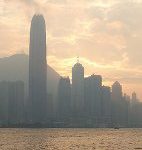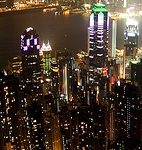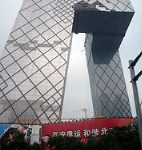Continuing pollution from port-related activities in Hong Kong and the Pearl River Delta (PRD) represents a long-term threat to public health and future economic development, Hong Kong-based think-tank Civic Exchange says in a new report, Green Harbours: Hong Kong and Shenzhen – Reducing Marine and Port-Related Emissions. It is vital for the ports and associated logistics industries to address the problem sooner rather than later. The industry is ready for the government to regulate it and act as a convenor to encourage discussions across sectors and borders. The government must now ensure a level playing field, so the industry can effectively implement green initiatives without its members losing their competitive advantage.
In compiling the report, Civic Exchange sought the views of stakeholders from Hong Kong and the PRD. It was the first time that members of the shipping, port, local craft and trucking sectors spoke to each other about environmental concerns across the industry.
Hong Kong and the PRD have some of the busiest ports in the world and throughput is only expected to grow. Millions of people in the region live and work in close proximity to port facilities and are directly exposed to harmful levels of shipping and port-related emissions. Toxic emissions from ships and port-operations represent a danger to public health and a long-term threat to the economy.
Governments and the various players in the maritime sectors of Hong Kong and the PRD have already implemented some positive measures, which include encouraging the use of low-sulphur fuels by ships, barges, port vehicles and equipment; using electricity to power port machinery; reducing fuel consumption; and using quay-side electrification. The more progressive companies are looking at how to reduce their carbon footprint.
Although these measures in themselves are not sufficient to reduce emissions on a scale necessary to protect public health, they do form a solid foundation on which to do more. There is a willingness among stakeholders to do better, but they need government regulation to create a level playing field so that laggards do not benefit from non-action. Thus, marine and port-related emissions, in fact, represent a quick win for the authorities.
One of the most important tools to reduce marine emissions globally and regionally is Annex VI of the International Convention for the Prevention of Marine Pollution from Ships (MARPOL Convention), enforced by the International Maritime Organization (IMO). Annex VI stipulates that the sulphur content of fuel used in ships cannot exceed 4.5% and sets limits on nitrogen oxide (NOx) emissions. Both Beijing and Hong Kong have ratified Annex VI, and are now bound by any future modification to Annex VI.
Recent discussions within the IMO have resulted in proposals for the revision of Annex VI, to be adopted in October 2008, as part of the ongoing process of setting global fuel and engine standards. Central to these talks is reducing the sulphur content of fuel in ships in global waters, and in Emission Control Areas (ECAs – areas close to ports and population centres). However, the current criteria for ECA designation is quite strict, and perhaps an unrealistic option for the PRD. However, negotiators at the IMO are considering ways to gradually increase the demand for cleaner fuels to ease the change for refineries, either by relaxing the criteria for ECA designation, and encouraging more of them to be created, or by suggesting emission limits that countries could implement in their territorial waters (this would be independent of the IMO, but would nevertheless encourage global consistency). These options could work well for the PRD region, and other Chinese port areas.
The health impact of marine and port-related air pollution is not a problem unique to Hong Kong and southern China. In North America and Europe, ports, governments and maritime industries are developing solutions to protect public health by way of regulations, incentive programmes, award and recognition schemes, comprehensive plans and policies, research and cross-interest collaborations. Vocal local communities and environmental groups have also played a role in bringing this issue to the attention of ports and local authorities.
While its efforts do not go far enough, the Hong Kong Government has promoted various initiatives to reduce sulphur emissions. Port operators in Hong Kong and Shenzhen have taken steps to clean up their operations. Some shipping companies, fearing the adoption of a worldwide patchwork of national and coastal emissions standards, have begun to use cleaner fuels and emission-reducing technologies on their engines when approaching ports. So far, however, this practice is not widespread in Hong Kong or the PRD.
Shipping companies, as well as port, local craft and truck operators, are willing to use cleaner fuels and follow best emission abatement practices, as long as regulations are implemented that will apply to all competitors across the board to ensure a level playing field. Bringing together competitors from across the industry is a critical part of reducing emissions. The Hong Kong Government and the Shenzhen authorities are best-placed to convene the dialogue that needs to take place to make this happen. Ratification of Annex VI was an important step for Hong Kong, but it is only the first move of what should become a comprehensive plan to reduce marine air pollution from harbour and river craft, ports, and trucks.
There are many initiatives that can be taken in the short term to improve air quality, such as reducing ship speed in PRD and Hong Kong waters, using cleaner fuels, or training staff to use existing machinery more efficiently to reduce fuel consumption and thus reduce emissions. In the medium-term, there is an urgent need to create an inventory of marine emissions in the PRD, improve Hong Kong’s inventory and to make these available for research and policy formulation. Without this information, it is difficult to create effective policy that targets emissions from marine sources. By looking at the experience and best practices of other port regions as well as taking advantage of the willingness in the industry regionally to clean up their operations, authorities in Hong Kong and Shenzhen can take an important step in protecting public health by reducing toxic emissions from this polluting industry.
Veronica Galbraith is a researcher at Civic Exchange
Lynne Curry is an independent environmental consultant
Christine Loh is the CEO of Civic Exchange
Homepage photo by OZinOH



